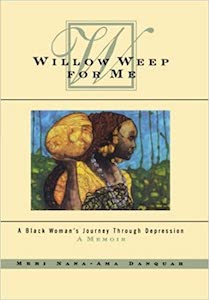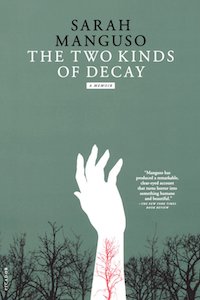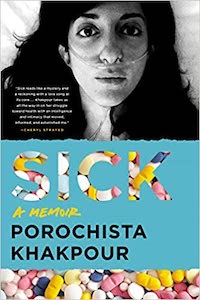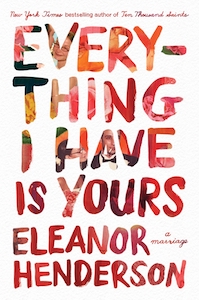Every time we move to a new house, I pack my necklaces the best way I know how, usually in a shoebox stuffed with underwear and socks. Sometimes Scotch tape is involved. As carefully as I try to keep the strands separate, they always end up snarled together by the time I open the box. The silver chains, the pendants, the love beads, the plastic charms my kids strung on a length of yarn. The more I try to separate them, the more deeply knotted they become.
Writing a memoir about my husband’s illness felt like this: trying to untangle a nest of necklaces.
Illness? Illnesses? There was the immediate physical illness, what we came to call the “chronic illness,” though this term felt indeterminate. Were the skin lesions related to the ankle swelling related to the dizziness related to the smell of maple syrup emanating from his neck? Then there was the mental illness, another universe with equally undefined borders. Were the hallucinations (were they hallucinations?) related to the mood swings related to the sleeplessness related to the paranoia?
And like a lot of people with both chronic and mental illness, there was a backpack full of childhood trauma and drug use. As we traveled from specialist to specialist—dermatologists and neurologists and psychiatrists and health coaches—his medical chart grew to well over 300 pages, and every page was another clue to untangle, another jeweled arc of the Venn diagram. If I could just undo the knot, I thought, I could get to the root of his disease, his damage, find that first loop that sent the whole system awry.
While working on my book, Everything I Have Is Yours, I turned to a well-established genre of so-called “Sick Lit,” memoirs of illness. There are also, of course, well-established genres adjacent to Sick Lit: the mental illness memoir, the trauma memoir, the addiction memoir. But I also turned to an emerging hybrid genre that is beginning to acknowledge the porous borders between all of these literatures. Naturally, this genre parallels progressions in our cultural and scientific understanding of the symbiotic ecosystem of the mind and body.
As of this writing, Dr. Bessel van der Kolk’s modern classic The Body Keeps the Score: Brain, Mind, and Body in the Healing of Trauma is number one on the New York Times Paperback Nonfiction Bestseller List, a list it has occupied for going on three years. This tells me that we have a new and insatiable desire for evidence of the ways our bodies and brains suffer together. We want stories that mirror our experiences in a way that feels truer than the neat diagnoses of traditional health care. So, many of these stories are also stories of navigating the inequities and inanities of a broken system, of becoming one’s one detective, one’s own doctor.
My husband, even at his most afflicted, is the one with the patience to untangle my necklaces—a love language I didn’t know I needed. And he was the one who healed himself. It wasn’t really my job to untangle anything. But now that I’ve tried, I have more awe for the boundless forces of human pain and recovery.
These four brilliant memoirs by women writers gave me the same.
*

Meri Nana-Ama Danquah, Willow, Weep for Me: A Black Woman’s Journey Through Depression (1998)
This book isn’t new, and its subject is seemingly straightforward. But it’s a book that captures the very embodiment of depression, the way that, as the now-familiar antidepressant ad goes, “depression hurts.” With Meri Nana-Ama Danquah’s depression comes insomnia, anxiety, panic attacks, “a cauldron of poisonous emotions,” and a “cobweb of fatigue.” A heaviness, though not a darkness—as a Black woman, she resists the pervading correlation between darkness and menace. In fact, she began writing the book shortly after William Styron’s Darkness Visible was published in 1989 and a magazine editor suggested she write about her experience with depression, differentiating it from Styron’s. “We had the same illness; the similarities end there,” Danquah told him. “I’m a single Black mother about a half a paycheck away from the government cheese line.”
1989 was also the year Kimberlé Crenshaw introduced the term “intersectionality,” and Danquah’s exploration of depression is remarkable for its intersectional fullness. She comes to understand depression as not just a chemical or genetic condition but a cultural and social one. “I am Black; I am female; I am an immigrant. Every one of these labels plays an equally significant part in my perception of myself and the world around me.” Her story begins in 1992 in Los Angeles, as the verdict of the Rodney King trial comes down, sending her city into a riot and Danquah into a spiral of despair. “Many Black women were marching the streets, bearing arms, battling men, battling each other, dressing the dead, aching in their wombs.” That night, getting into bed, she listens to Billie Holiday’s song “Willow, Weep for Me,” and feeling comforted by the way the singer’s voice “carried the tune of my worries gracefully,” she’s determined to begin facing her illness.
This is not an easy journey for Danquah, who grew up in a Ghanaian-American community fiercely resistant to mental health treatment. “Take your troubles to Jesus, not no damn psychiatrist.” She also faces the deeply ingrained racism of the medical field, including white therapists unable to fathom her experience as a Black woman and unwilling to accept her pain. In a year when Black athletes like Naomi Osaka and Simone Biles are crucified for prioritizing their mental health, it’s humbling to imagine the uphill battle Danquah must have faced in the 80s and 90s as she tried to seek help. “When a Black woman suffers from a mental disorder, the overwhelming opinion is that she is weak. And weakness in Black women is intolerable.”
What also makes Willow, Weep for Me remarkable is the way it captures the slippery slope between depression, self-medication, and addiction. “When the [Zoloft] samples ran out I found another way to treat the anxiety—alcohol. It got the job done and it wasn’t as hard on the pocket.” In one scene, Danquah is hunting through her purse for coins to see if she has enough money for one of those “drink-alone-sized bottles of wine, which smelled like nail polish remover and made me sick.” It’s at this point that her teenage sister calls to tell her, bravely, that she has been seeing a therapist and has been prescribed Zoloft—unaware that her sister has been living a parallel life. It’s a breakthrough for a family that, like many, suppressed any discussion of mental illness. It’s validation that the depression is a disease, and a family one. It takes Danquah a while longer, though—until she finds herself mixing a drink with the peach juice from one of her daughter’s fruit cups—to realize she needs help with alcoholism.
“All clinical depressions are a mixture of the emotional and the biochemical,” Danquah writes; “the illness exists somewhere in that ghost space between consciousness and chemistry.” Also impacting her depression: sexual abuse, domestic abuse, systemic racism, pregnancy, poverty. Danquah investigates the “ghost spaces” of these intersections—and her climb out of silent suffering—with courage and insight.

Sarah Manguso, The Two Kinds of Decay (2008)
Manguso begins her first memoir seven years into remission for chronic idiopathic demyelinating polyradiculoneuropahthy (CIDP), an autoimmune disease marked by numbness and paralysis, which she was diagnosed with in college. She wants to remember the story of her illness. “Not understand. Just remember.” With the clinical precision of a surgeon and the emotional imagination of a poet, she cuts a scalpel-fine picture of those terrible hospital-bound years, and the painfully tedious yet world-shaping experience of having her blood washed—the plasma removed and replaced. “My blood came out dirty and went in clean. It came out hot and went in cold. It came out old and went in new.” We feel the nerve endings of each symptom and every thought and feeling about each symptom. It’s bloody and visceral and not pretty, and sometimes not nice. If Sylvia Plath had CIDP, she might have written this memoir.
The irresistible metaphor of autoimmune disease is suicide, Manguso notes. The self killing the self. But as the disease progresses, suicide becomes more than a metaphor. “Was the CIDP a physical manifestation of a spiritual illness?” she wonders. “Did the medication trigger the depression, or did the depression trigger the CIDP?” And “What came first… the suicidal depression or the suicidal auto-immune disease?”
Manguso doesn’t really have answers, and maybe this is what she means by remembering, not understanding. But maybe remembering is a form of understanding. “There are two kinds of decay,” she concludes, “mine and everyone else’s.” She’s also writing about the decay of life—our slow, daily death—and the decay of a particular disease process, two forces she can’t really separate. She’s also, I think, talking about the decay of the spirit and the decay of the body, which she can’t really separate either.
When her suicidal depression deepens enough to land her in the psych ward, Manguso finds meaningful companionship with the other patients. “What I mean is that we all knew we had already lived through hell, that our lives were already over, and all we had was the final descent. The only thing to do on the way down was radiate mercy.”
Mercy is the most consistent palliative for the autoimmune patient and the psych patient. The Two Kinds of Decay radiates mercy, a syringe of it cleanly injected into a vein, and asks us not to look away as the needle goes in.

Porochista Khakpour, Sick (2018)
I have a vivid memory of reading Porochista Khakpour’s Sick the summer my husband’s mind and body were on fire. I was sitting on the deck eating a piece of avocado toast while he raved manically inside, sleepless for days. “[Y]ou hear a lot about the joint pain and muscle aches,” I read, but “the first symptoms of Lyme for most are anxiety, depression, and insomnia… Lyme attacks soft tissues in the body, and the brain is one of its favorite organs to feast on.” Khakpour’s book chronicles her journey to and through a diagnosis of chronic Lyme Disease, and I felt at that moment that I was experiencing a milestone on our own journey: discovering the knot between my husband’s chronic and mental illness. Khakpour describes the maddening “scissoring” of physical symptoms (numbness, weakness, debilitating fatigue) and mental ones (panic attacks, disorientation, suicidal depression). “How could my body erupt in a chaos of spirochetes each time my mind and body suffers?” she wonders. “How does that work? And yet we continue to find evidence of the mind and body connection.”
One of the tenderest bruises she presses on is “the link between chronic illness and PTSD.” As she puts it, “The disability or illness itself could cause PTSD, and the experience of going for years undiagnosed and then misdiagnosed as many like myself do can cause considerable trauma.” This kind of obsessive tracing of cause and effect, of chicken and egg, is familiar from The Two Kinds of Decay, but in Sick, the author sounds like a friend you haven’t seen in years who you stay up all night with, listening to her tell story after story about all the shit she’s been dealing with, over cigarette butts and empty drinks.
On her way to the Lyme diagnosis, Khakpour spends years in and out of doctor’s offices across the East-West spectrum, meeting doctor after doctor who don’t know what to do with the complexity of her case, and who treat her Lyme diagnosis with raised eyebrows at best. She picks up comorbid diagnoses as she goes (PTSD, PCOS, somatic disorder, an extreme sensitivity to mold). For these ailments and others, she is prescribed everything from Ambien to Klonopin to Neurontin, and her dependency only clouds her understanding of the convoluted system of symptoms she’s experiencing. “Was this really the pills? My injured brain? Was something off on a deeper level?… And of course, a third element then came to visit, less Technicolor than anxiety and panic, but a dark blanket of smoke, unchanging, unbreathable, thick, immovable: depression… Everything hurt, every part of my body felt like its wiring was all wrong. I felt like a foreigner in a hostile country.”
Like Danquah, Khakpour is an immigrant who ended up in LA. For her, the otherness she felt during her American childhood powerfully impacted the way she understands her illness. “My body never felt at ease,” she writes; “it was perhaps battling something before I knew what it was.” What’s stunning about Khakpour’s memoir—other than its capacity to capture the granular dehumanization of disease and the health care system—is the way she questions what we want and expect of illness, and illness memoirs. “I am a sick girl,” she says in the end. “I know sickness. I live with it. In some ways, I keep myself sick.” Although her health generally improves over the course of the book, the chronic nature of illness—indeed, the spirochete shape of the bacteria that causes Lyme—is at work in the shape of this memoir. She isn’t going to give us the happy ending of healing that we all demand of medical mysteries. The complexity of her condition means she can’t. But she gives us a brutally honest account of that condition, of the inexorably intricate ways we inhabit our bodies.

Esmé Weijun Wang, The Collected Schizophrenias: Essays (2019)
The Collected Schizophrenias has done more to destigmatize schizophrenia than any book since Elyn R. Saks’s 2007 memoir The Center Cannot Hold. Like Saks, Esmé Weijun Wang presents an intimate and absorbing account of what it’s like to live with “the archetypal disorder of lunacy” as a highly accomplished person. (Wang attended Stanford and Yale.) As the title suggests, The Collected Schizophrenias is a grab bag of symptoms, states, memories, and associations: a collage of highly personal essays. Her story begins around the time she’s given a diagnosis of schizoaffective disorder, but she reminds us that “psychiatric diagnoses are human constructs, and not handed down from an all-knowing God on stone tablets; to ‘have schizophrenia’ is to fit an assemblage of symptoms.”
Wang almost personifies the brain, so vividly does she invoke it as damaged, impaired, sick.
It is also, she posits, to simply have a disease of the brain, that concrete organ that lives in our skull and that makes us who we are. Wang almost personifies the brain, so vividly does she invoke it as damaged, impaired, sick. She quotes one professor who describes the tissue damage of schizophrenia as “[moving] across the brain like a forest fire.” She wants “more science” in psychiatry, demanding that we remember that the brain can sicken, like a heart or the lungs. Brains, we are learning, are also exceptionally plastic: they can get sick, and they can also get better.
Wang writes with curiosity, specificity, and seeming fearlessness about her periods of sickness and wellness. Once, her husband calls out when burning an egg and she ends up cowering in a closet. Once, she calls him to complain about “spiders eating holes in my brain.” Three times, she is hospitalized against her will. She accepts the schizoaffective disorder diagnosis as one does a hand-me-down pair of pants, gratefully but a bit skeptically. Does it fit? Does it flatter? She has nothing against hand-me-downs, but maybe there is a better pair of pants out there for her.
Wang’s skepticism means she’s not willing to accept any single explanation for her illness, perhaps because her trauma history is so deep and varied. Although she writes powerfully about the trauma of sexual assault and of being kicked out of college, she writes that the trauma of being held against her will in the psych ward was perhaps the worst she survived.
Compounding the PTSD is a parallel strand of chronic illness. Around the same time, Wang, like Khakpour, receives a diagnosis of chronic Lyme disease. Khakpour even makes a brief appearance to do a Lyme treatment with her. This diagnosis, too, she tries on with a critical eye, measuring her many doctors’ theories against her own. “Lyme disease may have escalated my existing psychiatric condition by triggering an immune reaction. Or… Lyme might have directly affected my brain, causing the symptoms that led to a diagnosis of schizoaffective disorder. Perhaps I don’t have chronic Lyme disease at all, but something else that may or may not be recognized by the CDC.” One neurologist even suggests, “Someday, we’ll be able to trace all mental illnesses to autoimmune diseases. But we’re not there yet.”
Wang navigates the Lyme landscape as though with a cane, poking its edges for soft spots. “A chronic Lyme diagnosis is like a belief system,” she comes to realize. To fully embrace any one way of understanding her body is to abandon all others. Though she longs for scientific accuracy, she also possesses and insists upon an expansive sense of the body’s narrative possibilities. She writes about the ways a diagnosis—essentially a bit of language dreamt up by people—profoundly affects the way we conceive of ourselves. Language limits, makes the unknowable knowable. The magic of The Collective Schizophrenias is that it gives us an assorted collection of ways to know ourselves—all of them acceptable, mysterious, and human.
__________________________________

Everything I Have Is Yours is available from Flatiron Books. Copyright © 2021 by Eleanor Henderson.



